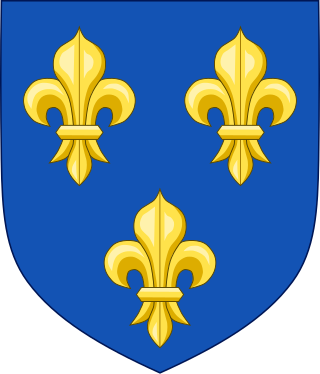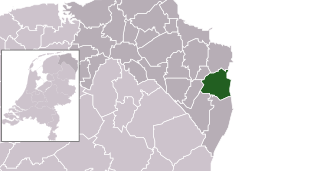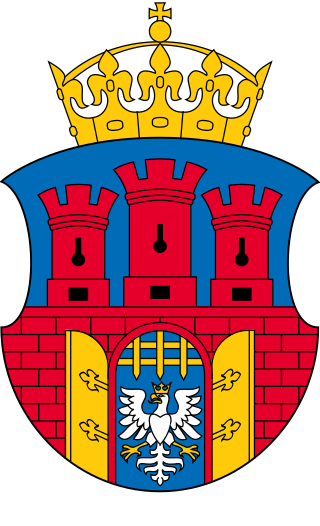
The fleur-de-lis, also spelled fleur-de-lys, is a common heraldic charge in the shape of a lily. Most notably, the fleur-de-lis is depicted on the traditional coat of arms of France that was used from the High Middle Ages until the French Revolution in 1792, and then again in brief periods in the 19th century. This design still represents France and the House of Bourbon in the form of marshalling in the arms of Spain, Quebec and Canada, for example.

Bellingwedde was a municipality in the province Groningen in the northeast of the Netherlands. Bellingwedde was established in 1968, when the municipalities of Bellingwolde and Wedde merged. After almost 50 years, Bellingwedde was disestablished in 2018, when the municipalities of Bellingwedde and Vlagtwedde merged into Westerwolde.

The coat of arms of Nova Scotia is the heraldic symbol representing the Canadian province of Nova Scotia. It is the oldest provincial achievement of arms in Canada, and the oldest British coat of arms in use outside Great Britain. It is blazoned as follows: Argent, a saltire azure charged with an escutcheon of the Royal Arms of Scotland.

The coat of arms of the Kingdom of Sweden is the arms of dominion of the King of Sweden. It has a greater and a lesser version. The shield displays the "Three Crowns of Sweden" quartering the "Lion of Bjelbo", with an inescutcheon overall of the House of Vasa impaling the House of Bernadotte.
In heraldry, the field (background) of a shield can be divided into more than one area, or subdivision, of different tinctures, usually following the lines of one of the ordinaries and carrying its name. Shields may be divided this way for differencing or for purposes of marshalling, or simply for style. The lines that divide a shield may not always be straight, and there is a system of terminology for describing patterned lines, which is also shared with the heraldic ordinaries.
In heraldry, an ordinary is one of the two main types of charges, beside the mobile charges. An ordinary is a simple geometrical figure, bounded by straight lines and running from side to side or top to bottom of the shield. There are also some geometric charges known as subordinaries, which have been given lesser status by some heraldic writers, though most have been in use as long as the traditional ordinaries. Diminutives of ordinaries and some subordinaries are charges of the same shape, though thinner. Most of the ordinaries are theoretically said to occupy one-third of the shield; but this is rarely observed in practice, except when the ordinary is the only charge.

The city of Kraków uses a coat of arms, a seal, official colors, a flag, and a banner as its official symbols. Additionally, a number of semi-official and unofficial symbols of the city are also used.
Papal coats of arms are the personal coat of arms of popes of the Catholic Church. These have been a tradition since the Late Middle Ages, and has displayed his own, initially that of his family, and thus not unique to himself alone, but in some cases composed by him with symbols referring to his past or his aspirations. This personal coat of arms coexists with that of the Holy See.

The coat of arms of Scotland, colloquially called the Lion Rampant, is the coat of arms historically used as arms of dominion by the monarchs of the Kingdom of Scotland, and later used within the coat of arms of Great Britain and the present coat of arms of the United Kingdom. The arms consist of a red lion surrounded by a red double border decorated with fleurs-de-lis, all on a gold background. The blazon, or heraldic description, is: Or a lion rampant Gules armed and langued Azure within a double tressure flory-counter-flory of the second.

The coat of arms of Alabama depicts a shield upon which is carried the symbols of the five states which have at various times held sovereignty over a part or the whole of what is now Alabama. These are the ancient coat of arms of France, the ancient coat of arms of Crown of Castile for Spain, the modern Union Jack of the United Kingdom and the battle flag of the Confederate States. On an escutcheon of pretence is borne the shield of the United States. The crest of the coat represents a ship which brought the French colonists who established the first permanent European settlements in the territory. Below is the state motto: Audemus jura nostra defendere, meaning "We dare defend our rights."

Norwegian heraldry has roots in early medieval times, soon after the use of coats of arms first appeared in continental Europe. Some of the medieval coats of arms are rather simple of design, while others have more naturalistic charges. The king-granted coats of arms of later times were usually detailed and complex. Especially in the late 17th century and the 18th century, many ennobled persons and families received coats of arms with shields containing both two and four fields, and some even with an inescutcheon above these.

The Spanish autonomous community and province of La Rioja has a coat of arms, which was assigned to the former province of Logroño in 1957, and to the present autonomous community on its foundation in 1982. It consists of a shield which is divided vertically into two halves, featuring respectively the Cross of Saint James and a castle, and is surmounted by a royal crown. Also depicted are Monte Laturce and the Ebro river.

Bellingwolde is a village with a population of 2,655 people in the municipality Westerwolde in the Netherlands. It is situated in the southeast of the region Oldambt, in the north of the region Westerwolde, and in the east of the province Groningen, at the border with Germany.
In heraldry and heraldic vexillology, a blazon is a formal description of a coat of arms, flag or similar emblem, from which the reader can reconstruct the appropriate image. The verb to blazon means to create such a description. The visual depiction of a coat of arms or flag has traditionally had considerable latitude in design, but a verbal blazon specifies the essentially distinctive elements. A coat of arms or flag is therefore primarily defined not by a picture but rather by the wording of its blazon. Blazon is also the specialized language in which a blazon is written, and, as a verb, the act of writing such a description. Blazonry is the art, craft or practice of creating a blazon. The language employed in blazonry has its own vocabulary, grammar and syntax, which becomes essential for comprehension when blazoning a complex coat of arms.

Wedde is a village in the municipality Westerwolde in the province Groningen in the Netherlands. It is located 9 km southeast of Winschoten. The castle Wedderborg is located in the village.

In heraldry, an orle is a subordinary consisting of a narrow band occupying the inward half of where a bordure would be, following the exact outline of the shield but within it, showing the field between the outer edge of the orle and the edge of the shield.

The coat of arms of Beverwijk is a coat of arms that has been renewed several times. The coat of arms of Beverwijk is the only coat of arms of a Dutch municipality that is surrounded by a cloak. This is highly unusual in the Netherlands, where such a cloak is normally reserved for nobility, the pope and national coats of arms.

Museum de Oude Wolden, abbreviated as MOW, is a regional museum in the village of Bellingwolde in the Netherlands. The museum focuses on art and history of the regions of Oldambt and Westerwolde in the east of the province of Groningen.

The Rechthuis is a former courthouse in the village of Bellingwolde in the Netherlands. The building with two crow-stepped gables was established in 1643 and used as a civil court for the area Bellingwolde-Blijham until 1811. The building has been a national heritage site since 1972. It is currently used as a private residence.

Westerwolde is a municipality in the province of Groningen in the northeast of the Netherlands.





















